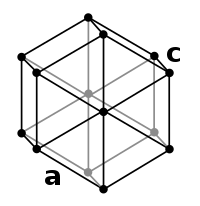
Photo from wikipedia
The development of sulfur cathode materials for lithium–sulfur (Li–S) batteries has significant technical challenges owing to poor conductivity and “shuttle effect” of the polysulfide dissolution. In recently, many efforts have… Click to show full abstract
The development of sulfur cathode materials for lithium–sulfur (Li–S) batteries has significant technical challenges owing to poor conductivity and “shuttle effect” of the polysulfide dissolution. In recently, many efforts have been made to improve the electrochemical performance of cathode materials for Li–S batteries. In the present investigation, MgO-doped and nitrogen-rich carbon nanofibers have been prepared via electrospinning technology under carbonization treatment. Ultrathin ZnO nanolayer is further coated on the surface of the carbon nanofiber by atomic layer deposition and then sulfur is loaded inside the nanofibers to achieve a C–MgO/S@ZnO composite. This composite was used as cathode material in Li–S batteries. They are exhibited maximum rate capabilities of 1066.08 and 846.75 mA h g −1 at 0.5 and 2 C, respectively. Moreover, the discharge capacity is 812.67 mA h g −1 after 100 cycles at 2 C and the capacity decay after 100 cycles is as small as 0.04% per cycle. The excellent electrochemical performance of C–MgO/S@ZnO nanofibers could be ascribed by the rational design due to the structure and composition of sulfur host.
Journal Title: Journal of Materials Science
Year Published: 2020
Link to full text (if available)
Share on Social Media: Sign Up to like & get
recommendations!